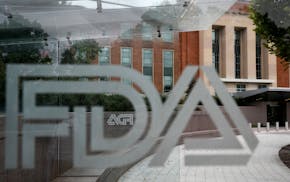In a bid to spur growth and avert the dangerous threat of deflation in the sluggish eurozone economy, the European Central Bank cut its benchmark interest rate to a record low and took the unprecedented step of lowering the bank deposit rate below zero.
The announcement Thursday in Frankfurt, Germany, marks the first time that a major central bank has pushed a key rate into negative territory. Not even the Bank of Japan during its two-decade battle with deflation or the U.S. Federal Reserve in the wake of the Great Recession has tried such an unusual approach.
The negative-rate move was the most eye-catching of a series of steps unveiled by Mario Draghi, president of the ECB, who two years ago helped stabilize the eurozone by saying the central bank would do whatever it takes to preserve the euro currency.
On Thursday, he sought to express similar resolve in fighting ultralow inflation. "Are we finished? The answer is no."
By lowering the overnight bank deposit rate to negative 0.1 percent from zero, the ECB will be charging lenders to park their funds with the central bank. The hope is that this will spur banks to make more loans and also weaken the euro, helping to lift an inflation rate that dropped to a four-year low of 0.5 percent in May.
Fears of deflation, a condition of falling prices, have increased amid persistently high unemployment and constrained government budgets, particularly in the eurozone's periphery.
Deflation cuts into business profits, raises real debt burdens and discourages consumer purchases, hampering investments and jobs. The strong euro has not helped because it has damped inflation by lowering import prices while also making Europe's exports more expensive in foreign markets.
As rare as the negative deposit rate is — Denmark tried the move in 2012 but saw little effect — analysts said it isn't likely to bolster lending. For one thing, the negative 0.1 percent rate is too small to change banking behavior.
At the same time, in taking what many view as a radical step, the ECB may see results if businesses and consumers believe that prices will not be falling and, thus, not change their spending behavior.
"The negative rate is a great headline for the ECB," said Jacob Kirkegaard, a senior fellow at the Peterson Institute for International Economics in Washington. "It shows the ECB is willing to do crazy, radical things to avoid deflation. That's why the PR from this move is very important."
On the whole, however, investors and analysts alike were not terribly impressed with the ECB's plans.
The central bank's main refinancing rate was trimmed to a new low of 0.15 percent from 0.25 percent, but markets had hoped for an even larger cut. The ECB also said it would support lending with a targeted injection of long-term credit for banks and a boost to the money supply.
Initially, European stock markets rose on the announcement and the euro fell against the dollar to $1.35, the lowest level since early February. But stocks gave up the gains later and the euro strengthened and ended the day above $1.365.
The ECB's actions "are significant but far from historic, and by themselves will not kick the eurozone economy into higher gear," said Mark Zandi, chief economist at Moody's Analytics.
For that to happen, he said, the eurozone has to strengthen its banking system, and Germany, the currency zone's powerhouse with its large surplus, needs to boost domestic demand.
What's more, Zandi and other analysts said the ECB may still need to employ an aggressive program of buying assets, similar to those by central banks in the U.S. and Japan, where consumer prices have been edging higher.
The ECB said it was engaging in "intensified preparatory work" to buy asset-backed securities. But it was unclear when the central bank would be ready to make purchases.
Regardless, analysts said the ECB board was not endorsing the kinds of massive government bond purchases, known as quantitative easing, that were undertaken by the Fed and the Bank of Japan.

Senate passes bill forcing TikTok's parent company to sell or face ban, sends to Biden for signature
USPS commits to rerouting Reno-area mail despite bipartisan pushback and mail ballot concerns

